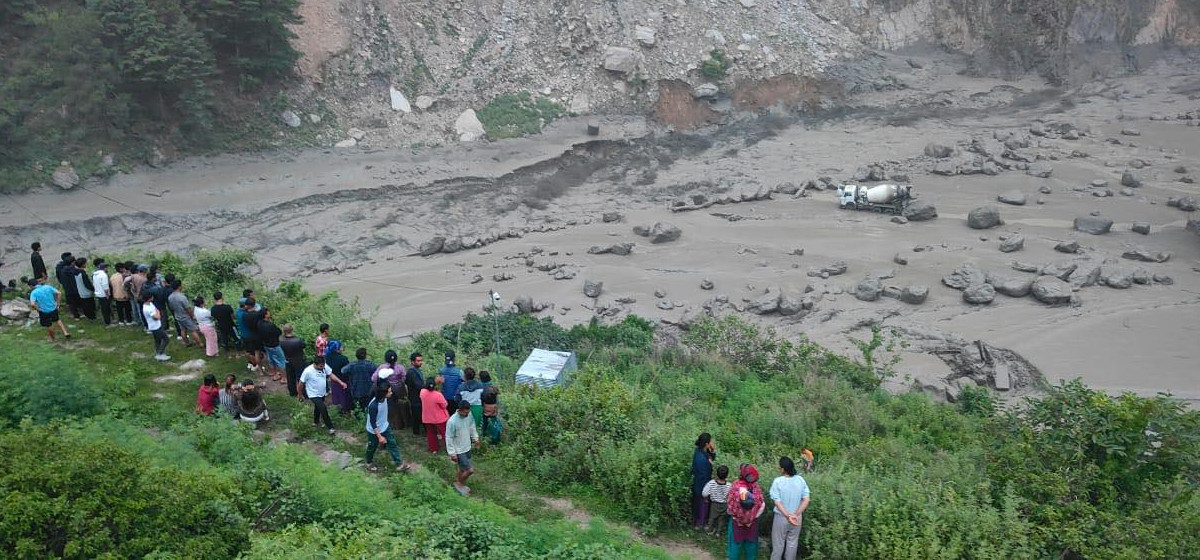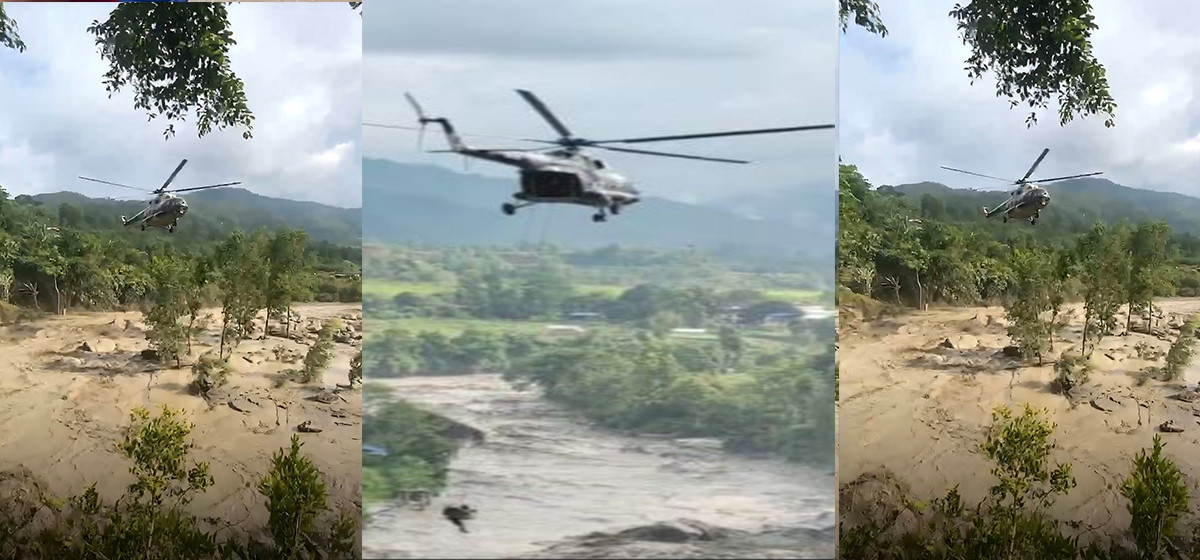KATHMANDU, July 9: An unforeseen disaster struck chaos in Rasuwa and neighbouring districts in the wee hours of Tuesday, leaving at least nine people dead and 20 reported missing. A sudden flash flood in the Bhote Koshi, a tributary of the Trishuli river, at around 3:15 am on Tuesday devastated the settlements and infrastructure on the banks of the river and also washed away the Friendship Bridge between Nepal and China.
By the time Republica went for print, as many as 57 individuals stranded in the disaster zone were rescued by security forces with the Nepali Army airlifting as many as 30 injured individuals with its helicopters.
The flooded Bhote Koshi, which is also known as the Lhende Khola, carried away at least nine people, whose unidentified bodies were recovered downstream miles away from Dhading and Chitwan districts. One of the deceased is suspected to be a police personnel.
Of the 20 individuals reported missing, three are security personnel and six are Chinese nationals. According to the Armed Police Force (APF), those missing include Assistant Sub-Inspector Lal Bahadur Shrestha and police constables Munna Thakur and Lokendra Bohora, all stationed at the Area Police Office in Timure.
Similarly, the six missing Chinese nationals have been identified as Yu Yui, Li Huachin, Yang Chuan, Yu Hai Hang, Yu Qiao Chui, and Zhou Yong.
The flood damaged four hydropower projects in the district affecting the supply of at least 211 MW of electricity to the national power grid. According to Rasuwa's Assistant Chief District Officer Dhruba Prasad Adhikari, the flood swept away a total of 64 items, including 23 cargo containers, six freight trucks, and 35 brand-new electric vehicles.
GLOF, avalanche or permafrost melting?
Bhote Koshi wreaked havoc without heavy rain: What caused the f...

Experts have pointed out that the sudden flooding occurred either due to a Glacial Lake Outburst Flood (GLOF), an avalanche or rapid permafrost melting.
Senior Divisional Hydrologist at the Department of Hydrology and Meteorology (DHM) Binod Parajuli told Republica that while all three of the disaster incidents types could have triggered the flood, it is more likely it was caused by a GLOF that took place in either Nepal or China.
“We are still collecting data on the situation of the glaciers through the visual samples provided by the rescue helicopters deployed by the army,” Parajuli said, “There are a number of glacial lakes on either side of the border in the region.”
He added that the DHM is coordinating with the Chinese Meteorological Association on a real-time basis to understand if a GLOF took place in China.
500 security personnel cut-off from backup
According to the security agencies, more than 500 security personnel in the district have all been deployed to assist in the ongoing rescue operations.
Nepali Army spokesperson Brigadier General Rajaram Basnet told Republica that 300 army personnel are involved in the rescue efforts in Rasuwa with two army helicopters mobilized for the rescue of injured individuals. The District Police Office (DPO), Rasuwa, reported around 120 police personnel are in the district while the Armed Police Force (APF) stated that 86 personnel from the force have been deployed for rescue efforts.
General Basnet added that army personnel have been tactically deployed to 17 different locations in the district in two phases for the rescue operation.
According to the spokesperson for APF Deputy Inspector General (DIG) Kalidas Shrestha, security forces have been cut-off from reinforcements for the rescue efforts after the flood damaged sections of the Pasang Lhamu Highway, restricting vehicular movement to the district.
“All the security personnel stationed in the district have been deployed for rescue operation,” DIG Shrestha told Republica, “However, the damage dealt to the roadways have cut-off reinforcements to the district.”
Spokesperson for Nepal Police DIG Binod Ghimire told Republica that in addition to 120 police personnel in Rasuwa, 95 personnel have been deployed in Nuwakot and 120 in Dhading as these districts also experienced the effect of the flash flood.
PM reaches site for inspection
Prime Minister KP Sharma Oli conducted an on-site inspection of the damage caused by the flood in the Bhote Koshi River in Rasuwa.
During his visit, Prime Minister Oli held discussions with local authorities, elected representatives, and residents regarding the extent of the damage, as well as ongoing rescue and relief efforts.
He expressed concern over the missing individuals, the damage to the Rasuwagadhi dry port at the Nepal–China border, and the destruction caused by the swept-away cargo containers. The washing away of the Friendship Bridge is expected to halt the trade between the two countries.
The prime minister was accompanied by Deputy Prime Minister and Finance Minister Bishnu Prasad Paudel, Home Minister Ramesh Lekhak, Minister for Energy, Water Resources and Irrigation Deepak Khadka, Chief Advisor Bishnu Prasad Rimal, Chief Secretary of the Government of Nepal Eak Narayan Aryal, Chinese Ambassador to Nepal Chen Song, the Chief of Army Staff Ashok Raj Sigdel, and the heads of all four security agencies.
Four hydro projects damaged
Four hydropower projects sustained damage due to the flood in the Lhende Khola along the Nepal–China border in Rasuwa. According to the Nepal Electricity Authority (NEA), the affected projects include Rasuwagadhi Hydropower, Trishuli 3A, Chilime Hydropower, and Beni Hydropower.
NEA stated that the Rasuwagadhi Hydropower Project suffered the most severe damage, with the flood sweeping away the gate of the dam. Local rural municipality chairperson Buchung Tamang also confirmed the damage to all four projects, emphasizing that Rasuwagadhi, with a capacity of 111 megawatts, was the hardest hit. The project's bridge was also washed away.
The 60-megawatt Trishuli 3A project experienced water intrusion into its buildings. Meanwhile, Chilime (21 MW) and Beni (19 MW) hydropower projects sustained relatively minor damage.



































